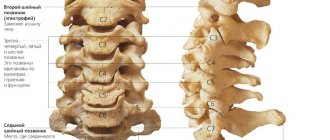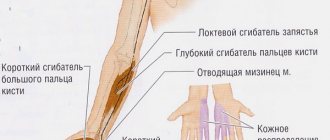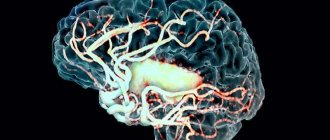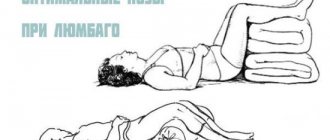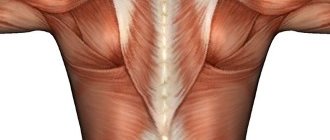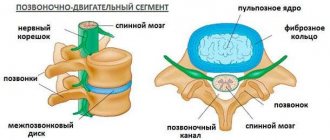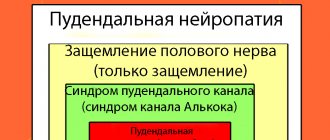Chest pain may be a sign of compression of the nerve roots in this part of the spine. With age, bone tissue disintegrates, the vertebrae come into contact with each other and pinch the nerves. Muscle spasms also often provoke pinching of the pectoral nerve.
For active people, sudden pain syndrome leads to decreased performance. There are no statistics on the number of patients who seek help when a pinched nerve occurs in the thoracic region. Many self-medicate, which can worsen the condition, resulting in the need for surgical intervention.
Signs and symptoms of a pinched nerve
The autonomic and sensory nerves are considered the most vulnerable.
When one of them becomes pinched, a throbbing and periodically tingling pain occurs in the cardiac region. It becomes difficult to breathe. If you try to take a deep breath, the pain will increase sharply. The symptoms are similar to a heart attack, but the cause is neuralgic. And if you take heart medications, there will be no relief. There is severe stiffness in the chest area. It becomes more pronounced when a person tries to make any movement. Localization of pain is felt from the ribs to the spinal region. Sometimes it is accompanied by heart rhythm disturbances. This often leads to an erroneous diagnosis when neuralgia is mistaken for a heart attack or ischemia. A pinched nerve, unlike heart problems, is accompanied by long-term painful sensations that cannot be relieved by medications.
If the nerve is severely compressed, stomach pain may be added to the rest of the symptoms, which resemble gastroenteritis, colitis, or ulcers. You can eliminate these diseases yourself. It is enough to take an antispasmodic. If it helps alleviate the condition, then the problem is gastroenterological in nature.
Pinching may be episodic. In other words, instead of prolonged pain, a person is tormented by attacks that differ in the nature of symptoms and duration. Often neuralgia can occur at night, when the body is at rest. The nerve often becomes pinched during moments of taking a relaxed position, when the muscles are not overstrained.
The most striking manifestation of neuralgia is pain in the chest. They bother one side of the body or encircle, spread along the intercostal spaces, radiating to the back, shoulder, and upper limbs. The pain is acute, burning, piercing, increases with exposure to irritants, from taking a deep breath, may be coughing, sneezing, bending/turning the body, and is sometimes accompanied by a decrease in sensitivity.
A person manages to feel trigger points in the intercostal spaces, along the spine, along the front wall of the chest. Seizures do not always begin after physical exertion and contact with external irritants; they develop both at rest and during sleep.
The symptoms of neuralgia change as different parts of the nerve fiber are affected. There are 4 types of pinching:
- in the anterior chest wall;
- compression of the nerve of the upper thoracic spine;
- compression of nerve fibers in the lower thoracic region;
- scapular-costal neuralgia.
A pinched nerve in the chest is manifested by pain. It is aching, localized in the armpit, along the parasternal line. Unpleasant sensations persist for a long time and increase with any movement. With scapular-costal neuralgia, the pain is short-term or constant. It is stabbing or aching, localized between the shoulder blades, radiating to the armpit, nipple area (usually on the left), and increases with inhalation or exhalation.
When a pinched nerve is diagnosed in the thoracic region (5–7 vertebrae), the discomfort is localized under the xiphoid process and resembles the symptoms of gastritis. Degenerative changes in Th10–12 initiate pain between the ribs, in the sub- or supraclavicular or epigastric region, radiating to the neck, left shoulder, and arm. They intensify when tilting or turning the head.
The difference between thoracic neuralgia and angina pectoris
When the upper segments of the thoracic spinal column are affected, the patient experiences a sensation of a foreign body in the pharynx, behind the sternum, which is accompanied by difficulty swallowing. A person suffers from chronic, aching pain in the heart area, between the shoulder blades; this condition can be confused with an attack of angina pectoris. Discomfortable sensations are constantly present and are not associated with movements.
Unlike intercostal neuralgia, cardiac pain syndrome occurs in attacks and lasts no more than 20 minutes. Patients complain of pressing pain in the chest, associated with physical activity and passing at rest. Nitroglycerin helps to quickly relieve discomfort.
Prevention
When the pain syndrome has passed, this does not mean that the disease has receded. Pinching may recur, so to avoid recurrence you should:
- Do not overeat to prevent stress on the spine.
- At the first opportunity, try to relax in sanatoriums and resorts by the sea.
- Correctly lift weights and carry bags by alternating shoulders.
- If your lifestyle is predominantly sedentary, then you should take breaks and exercise. The simplest thing is to walk back and forth.
- Protect your chest from the cold.
- It is recommended to perform a light gymnastic complex in the mornings and evenings.
To avoid pinched nerves, there are several rules of prevention:
- maintaining normal weight, losing weight if necessary;
- treatment in sanatoriums;
- no hypothermia;
- stable physical activity;
- avoiding carrying bags and heavy objects on one side of the body;
- proper nutrition, rich in vitamins, potassium and magnesium;
- constant control of posture;
- absence of long static loads;
- use of orthopedic mattresses;
- visiting the pool with crawl or breaststroke backstroke;
- taking therapeutic massage courses to help increase blood flow and reduce muscle tension;
- periodic visits to a chiropractor to correct spinal curvatures.
Preventive therapeutic massages will have a general healing effect and serve as a preventive measure for pinched nerves.
A pinched nerve is an unpleasant condition, but it can be treated without much difficulty if you consult a doctor in time. You should not self-medicate and put off going to a specialist for a long time, since getting rid of the disease in the initial stages is much easier than dealing with serious complications in more severe stages.
Home » Diseases » Neuralgia » Pinched nerve in the thoracic region: symptoms, treatment, prevention
The most susceptible to nerve entrapment are the cervical and lumbar spine. In the thoracic region, nerve pinching occurs much less frequently due to its inactivity. This occurs in people aged 30 years and older.
The fact is that with age, a person’s bones wear out and become thinner. Therefore, the intercostal nerve roots, which are located between the intervertebral discs, may become compressed by these discs or vertebral bodies.
This pinching is accompanied by a sharp aching pain in the chest and back. The pain may get worse when you make any movement or try to sneeze or cough.
The main cause of pinched thoracic nerve is considered to be intercostal neuralgia. Its aggravation can be caused by too sudden a movement, lifting an unbearable weight, or incorrect rotation of the body.
Nerve entrapment in the thoracic region and intercostal neuralgia are often confused with cardiovascular diseases due to similar symptoms. But with neuralgia, unlike other diseases, it is not possible to get rid of pain with the help of conventional analgesics. To determine an accurate diagnosis, you need to see a doctor and undergo the necessary examinations.
Other reasons why chest pain often occurs:
- The presence of a disease such as osteochondrosis can also cause a pinched nerve. With osteochondrosis, the vertebrae are displaced and the nerve is pinched. Disc protrusion or intervertebral hernia may occur.
- Congenital or acquired abnormalities in the structure and function of the spine can cause nerve compression. One example is a disease such as scoliosis.
- Hypertonicity of the back muscles. Usually occurs in people who play sports or undergo heavy physical activity. The muscles spasm and pinch the nerve endings.
- Tumor and inflammation of the spinal column caused by various factors can also cause pinching of the thoracic nerve.
- People with an unstable psyche, subject to frequent stress and depression, often have the problem of pinched nerves.
Older people and athletes are most susceptible to pinched nerves. Or people whose work requires heavy physical activity. And also people whose lifestyle, on the contrary, is sedentary.
Infringement of the nerve of the thoracic spine occurs only in mature and elderly people. Infants are not susceptible to pinched nerves in this part of the spine.
Most often, due to birth injuries or improper handling of a newborn, a pinched nerve in infants occurs in the cervical spine.
Diagnostics
A specialist will be able to determine the diagnosis of intercostal neuralgia without much difficulty. The doctor will ask the patient about his complaints and conduct some examinations:
- upon examination, you may notice redness or pallor of the skin over the pathological nerve;
- When you feel the damaged intercostal space, pain will appear.
If the doctor remains in doubt about making a diagnosis, additional research methods will be needed:
- radiography;
- Ultrasound;
- MRI;
- CT scan;
- myelography.
If necessary, an abdominal ultrasound and ECG may be required.
What causes the disease?
Elderly people are at risk. The natural processes of aging in the body do not pass without leaving a mark on bone tissue, the spine, and the nervous system. This in no way means that young people do not suffer from this disease. There are other reasons that provoke pinched nerve roots.
Neuralgia often develops against the background of vegetative-vascular disorders affecting not only the thoracic region. Almost everyone has this dystonia, which significantly expands the potential risk group. Such a violation manifests itself as weather dependence, that is, a reaction to changing weather conditions, severe headaches.
Autonomic nerves are characterized by increased sensitivity to any moral and psychological overload. People who consider themselves absolutely healthy often suffer from attacks of headaches and intercostal pain after enduring severe stressful situations.
The most common cause leading to a pinched nerve in the chest area is an exacerbation of a disease such as osteochondrosis, as well as increased muscle tone caused by a back problem. These two factors most often lead to the disease in question.
Exacerbation of osteochondrosis provokes convergence of the vertebrae against the background of deformation changes in bone tissue, which gives impetus to pinching of the nerve ending. Hypertonicity leads to spasms and does not allow muscles to relax, which has detrimental consequences. Both phenomena most often occur in people who deal with significant physical activity.
Pinching a nerve ending is not just pain, but also much more serious consequences. There is a disruption of normal blood circulation, which negatively affects the vascular system and does not allow the body to receive a sufficient amount of important enzymes transported by the blood. Nerve compression can also occur due to the presence of a hernia in the chest.
Nerves can become pinched when taking an uncomfortable position due to prolonged stress on the spinal region. The problem is preceded by the development of an intervertebral hernia. People suffering from osteochondrosis need to start treatment in a timely manner. Otherwise, pinching will begin to occur regularly.
A pinched nerve rarely occurs without associated pathologies, like most other diseases. The most common factors are the following:
- exacerbation of intercostal neuralgia due to sudden movements or heavy lifting;
- age-related changes leading to wear and tear of bones, cartilage and nervous system;
- osteochondrosis, in which nerve fibers are compressed due to disc displacement;
- protrusion of the intervertebral disc, in which the latter swells and extends into the spinal canal;
- intervertebral hernia, accompanied by protrusion of the intervertebral disc between the vertebral bodies themselves;
- various congenital or acquired postural disorders. The most common is scoliosis;
- muscle hypertonicity, which most often occurs in athletes who subject their back to severe physical activity. Spasmed muscles compress nerve endings and lead to pain;
- benign and malignant formations in the spine, in which all adjacent tissues are compressed due to the enlargement of the tumor;
- mental disorders, depression, stress;
- sedentary lifestyle, sedentary work;
- diseases of the cardiovascular system. Due to problems with blood circulation, the nutrition of the spine is reduced, less necessary substances are supplied to it and accelerated tissue degeneration occurs;
- vegetative-vascular dystonia provokes pinched nerves;
- uncomfortable postures during work or other activities for a long time;
- hypothermia leading to nerve inflammation;
- visiting saunas and baths, during which, due to the flow of blood, swelling of the nerve roots increases and the pressure on them increases;
- traumatic lesions of the spine (cracks, fractures);
- infectious lesions, including herpes zoster.
A pinched nerve in the thoracic spine is a consequence of changes in which the relationship of the vertebrae to each other is disrupted
Compression of the spinal nerve endings occurs during degenerative processes in the spinal column. The roots are pinched by displaced discs and processes of the vertebrae. Pain occurs with swelling, spasms of the muscle fibers of the back, chest, aseptic inflammation of damaged tissues after mechanical injuries.
Neuralgia is common among athletes and those who do hard work. A pinched nerve is a consequence of a sharp turn of the body, heavy lifting, or prolonged stay in an unnatural position. Strength exercises without preliminary warm-up provoke an attack.
Causes of pinched thoracic nerve:
- osteochondrosis, spondyloarthrosis;
- stenosis (pathological narrowing) of the spinal canal;
- Bekhterev's disease;
- intervertebral hernia;
- hypertonicity of the chest muscles;
- vascular atherosclerosis;
- scoliosis, kyphosis, lordosis;
- mechanical injuries of the spine, chest;
- osteoporosis;
- multiple sclerosis;
- benign, malignant tumors of the mediastinum;
- polyradiculoneuritis.
In women over 45 years of age, symptoms of thoracic neuralgia appear against the background of hormonal changes in the body during menopause. Pain syndrome can develop with atherosclerosis of blood vessels, metabolic disorders, pneumonia, and bronchitis. The provoking factor is a strong decrease in immunity, vitamin deficiency, frequent stress, hypothermia, chronic alcoholism, hormonal imbalance.
There is a distinction between true chest pain and thoracalgia - intercostal neuralgia. In the first case, discomfort is caused by damage to the heart muscle, pneumonia, and gastrointestinal diseases. In the second, vertebrogenic symptoms are associated with displacement of the vertebrae, protrusion of the intervertebral hernia, and narrowing of the spinal canal. These processes are accompanied by compression of the spinal nerve roots, and therefore acute pain.
Set of measures
Treatment for thoracic nerve entrapment depends on the cause of the compression of the spine. The primary goal is to release the pinched nerve and get rid of the reasons that caused it to be pinched. After this, you need to restore the functions of the released nerve.
For effective treatment, drug treatment is used. It includes taking the following medications:
- Sedatives
. They have a calming effect on the patient and help restore sleep. - Muscle relaxants
. Help relieve muscle spasms and eliminate pain. - Anti-inflammatory drugs
. Help relieve inflammation from the affected area. - B vitamins
. A lack of B vitamins in the body leads to a malfunction of the nervous system.
The following therapy methods are also used:
Folk remedies available for use at home can also be an effective addition to traditional methods of treatment for pinched nerves in the thoracic region.
There are many such recipes in folk medicine, let’s look at some of them:
- garlic oil is diluted in 0.5 liters of vodka and the affected area is rubbed with this mixture;
- a hard-boiled egg is cut and applied to the sore spot, held until it cools completely;
- pour boiling water over a tablespoon of peppermint leaves and drink half a glass of this decoction before bed;
- horseradish leaves are applied to sore spots and wrapped with woolen cloth on top.
First aid
It will take time before a person gets to the doctor, but the pain is unbearable. To alleviate the condition, you need to take a comfortable position, lie with your back on a hard surface, so that the pinching does not progress and the swelling does not increase.
You can take an NSAID and call a doctor. When a nerve is affected, blood supply to the affected area is reduced, so it is recommended to seek help as soon as possible.
You should not try to fix or treat anything yourself. The consequences can be serious.
First aid for spinal pathology is as follows: the patient should take a comfortable position or lie on his back on a hard surface - this will prevent further compression and swelling at the pinched site, take a painkiller or anti-inflammatory drug (NSAID) and call a doctor.
It is strictly contraindicated to make any adjustments yourself or self-medicate. This can lead to complications.
If the cause of the pain is not identified, it may recur after a certain time with the same intensity.
Drug therapy depends on the cause of the pinched thoracic nerve. In each specific case, the underlying disease that caused the pinching is treated.
If therapeutic treatment of spinal pathology is ineffective, novocaine (or lidocaine) blockade of the intercostal spaces is performed. This is a medical procedure done in a medical facility.
When a nerve is pinched in the thoracic region, treatment in the form of a set of special exercises is a fundamental method in the treatment of most types of skeletal pathologies.
Gymnastics helps strengthen the muscles of the spine, which leads to a decrease in pressure on the vertebrae, improves the functions of the spine, and increases the overall fitness of the body. A set of exercises for each patient is selected individually. For some time to master, everything is done under the supervision of an instructor, in the future you can study at home. If the pain syndrome resumes, this indicates that the gymnastics were performed incorrectly.
Other physiotherapeutic methods also help.
Massage helps relax the back muscles and release the pinched nerve, and physiotherapeutic methods improve its blood supply. Reflexology prevents the development of relapses, therefore it is used at the rehabilitation stage. In case of cardiac pathology, these types of treatments are contraindicated. In other cases it is prescribed individually.
- injuries;
- tumors;
- severe osteochondrosis;
- persistent spinal deformities.
Depending on the identified pathology and the severity of the condition, different surgical treatment methods are used. The doctor chooses a certain method based on the specific situation:
- discectomy - removal of a protruding section of the intervertebral disc;
- laminectomy - resection of the vertebral arch;
- spinal fusion - stabilization of the vertebrae;
- excision of the tumor.
If you seek medical help in time, the disease can be cured without surgery.
Pain that occurs in the chest and stomach can be caused by hundreds of different reasons, but the most common among them is pinched nerves in the thoracic region. This condition can be easily confused with other diseases of the internal organs, so in no case should you self-medicate; you should definitely consult a doctor.
State Description
Daily stress negatively affects the condition of the skeletal and nervous systems. Up to a certain point, a person may not realize that his vertebrae are being destroyed, but when pain sets in, it is discovered that degenerative processes have been occurring in the back area for a long time.
Video about diseases of the thoracic spine
Classification
There are several types of nerves that are susceptible to pinching in the spinal region:
- sensory nerve;
- motor nerve;
- autonomic nerve.
Sometimes the vagus nerve is pinched, which originates in the medulla oblongata inside the skull, goes down the neck to the thoracic region and then enters the abdominal cavity.
Causes and provoking factors
Symptoms
The manifestations of this condition are very diverse and sometimes depend on where exactly the pinched nerve occurred:
- when the autonomic nerve is compressed, pain in the heart occurs. When trying to inhale or exhale, it may get worse. The pain can be sharp, stabbing and extremely sharp for a long time. Heart medications do not improve;
- movements are constrained due to the inability to fully move. Sometimes even with the slightest attempt to bend or turn, acute pain occurs;
- pain can spread from the vertebrae to the ribs, radiate to the arms, neck, lower back;
- upper limbs go numb;
- Pain in the stomach appears, reminiscent of gastritis or an ulcer. Taking antispasmodics does not have a positive effect;
- Sensitivity of various types is impaired. The sensations in the area of the pinched nerve are partially reduced and, conversely, the sensitivity of the skin to touch increases;
- pinching of a sensory nerve is accompanied by acute pain at the site of its compression;
- pinched motor nerve may often not manifest itself, but subsequently leads to a decrease in motor activity.
Pain from a pinched nerve can be so severe that the patient cannot make even the slightest movement.
In especially severe cases, the patient may faint, and the pressure jumps from low to high.
Diagnosis and differential diagnosis
Differential diagnosis is carried out to exclude diseases of the heart, stomach and other internal organs. A doctor will be able to distinguish pathologies from each other based on examination and the body’s response to medications (antispasmodics, analgesics, cardiac medications).
If it is difficult to make a diagnosis, the doctor may prescribe an x-ray of the spine, ultrasound or magnetic resonance imaging. In some cases, myelography (x-ray using contrast agents injected into the spinal canal) is performed to identify the specific affected area.
MRI allows accurate diagnosis of entrapment
Treatment
At the first symptoms of a pinched nerve, you should consult a neurologist. Depending on the severity, the specialist will choose the appropriate treatment. It is worth advising the patient to take sick leave for a couple of weeks in order to maintain a gentle regimen. The back needs rest and rehabilitation so that the painful symptoms go away as soon as possible.
First aid
Often the first attacks occur suddenly, and before the doctor arrives you need to use available means to alleviate the suffering. During the first signs of pinching, you should try to immobilize the patient and place him on a hard, straight surface to avoid unnecessary pain. There is no need to impose a certain position, since the patient himself will select the most optimal body position, which will reduce discomfort.
You can take non-steroidal anti-inflammatory drugs, which are found in most home medicine cabinets (Movalis, Ibuprofen, Diclofenac). Local anesthesia with Ketanov ointment can also help, which should be applied to the back and areas where the pain radiates. If necessary, give the person an antipyretic and be sure to measure their blood pressure, as it can change greatly during an attack.
Ibuprofen has anti-inflammatory, analgesic and antipyretic effects
If the patient is very nervous and thereby worsens his condition, you can offer him a mild sedative sedative (Novopassit, Persen, Afobazol).
In case of difficulty breathing, free the chest from any stress, open the windows and provide a flow of fresh air.
Drug therapy
Depending on the cause of the pinching, the doctor may choose the following remedies for treatment:
- anti-inflammatory drugs (Diclofenac, Lornoxicam, Celecoxib) are the most common group of drugs. They have analgesic and anti-inflammatory properties;
- anti-spasm medications (Tizanidine, Tolperisone) are additionally prescribed in case of muscle hypertonicity;
- strong prescription painkillers (Tramadol) are prescribed if the combination of drugs described above does not produce a positive result;
- B vitamins (Neuromultivit) improve metabolic processes in nerve fibers;
- chondoprotectors (Teraflex, Chondroitin) improve blood circulation and metabolism in tissues. They are prescribed if the cause of the pinching is osteochondrosis.
Establishing diagnosis
If you have severe chest pain, you should seek help from a specialist. In order to determine the cause of the pain and prescribe the correct treatment, the doctor will prescribe the necessary examinations of the heart and spine.
To check your heart function, your cardiologist will order an electrocardiogram (ECG) and an ultrasound (ultrasound).
The spine is checked using and (MRI). Only with the results of these studies in hand will the doctor be able to accurately diagnose and prescribe treatment.
How to prevent a pinched nerve
When the pain has passed and the disease has receded, you cannot relax. If pinching occurs, it may happen again. To avoid relapse, you must adhere to the following recommendations:
- Try not to overeat. It is better to eat more often, but in smaller portions. Otherwise, the load on the vertebrae will increase.
- It is advisable, if the slightest opportunity arises, to try to relax in sanatoriums and resorts located by the sea.
- Of course, you won’t be able to completely give up carrying heavy bags. But the weight should be lifted correctly, periodically changing the shoulder.
- When work involves a predominantly sedentary lifestyle, breaks are a must. You can do gymnastics or just walk back and forth.
- The chest must be kept warm. Clothes should be chosen only according to the weather.
It is recommended to do light gymnastic exercises in the morning or evening.
Basic rules for the prevention of thoracic neuralgia:
- balanced diet;
- rejection of bad habits;
- moderate physical activity;
- optimal work and rest regime;
- protection against spinal injuries and hypothermia.
When working sedentarily, it is recommended to exercise regularly, warm up during the day, and use orthopedic chairs. Athletes should properly plan their training schedule and avoid overexertion. For osteochondrosis and other chronic diseases of the spine, preventive treatment is necessary; it is useful to visit sanatoriums, do back massage, and exercise therapy.
Surgery
When traditional medicine does not bring a positive result, the question of surgery arises. This is a last resort, prescribed only by a doctor.
The indications in this case are:
- - hernias;
- - injuries;
- - tumors;
- — osteochondrosis in an advanced stage;
- - established spinal deformities.
Among the methods used in surgery are:
- Excision of the tumor.
- Spinal fusion required to stabilize the vertebrae.
- Discectomy, which involves removing a protruding portion of the intervertebral disc.
- Laminectomy or resection of the vertebral arch.
Summarizing
It is important to remember that a pinched nerve in the thoracic spine has similar symptoms to disturbances in the functioning of the heart muscle. In order to carry out complex therapy in a timely manner and get rid of the disease, you must undergo an examination.
The lack of improvement after taking heart medications allows you to independently determine the need to see a specialist. They do not relieve pain. And if this is the case, you should see a doctor.
To prevent the risk of pinching nerve endings in the chest area, it is necessary to create conditions under which the muscles are not overstrained. Because this often leads to the occurrence of neuralgic pathology.
It is possible to cure pinched nerves only when the nerve is not simply released, but its normal function is completely restored. There is no one universal treatment method. Proper therapy involves a combination of medications, gymnastics, massage and other procedures. Otherwise, the problem will only be replaced by moments of relief, and the attacks will repeat.
When pinched, the nerve root becomes pinched between spinal discs or vertebrae. There may be several symptoms. The brightest is pain. It can be different and occur in the middle of the back, spreading to the neck or arms. The pain is unexpected. This often results in muscle spasm.
The peculiarity of a pinched nerve in the thoracic region is that attacks are often confused with heart failure due to the similarity of symptoms.
A pinched nerve in the thoracic region not only causes pain and discomfort, but also negatively affects the performance of the entire system and quality of life.
Pinching often occurs after an unsuccessful movement, but sometimes it can be a symptom of serious degenerative changes in the body.
State Description
A pinched nerve in the thoracic region is largely due to the peculiarities of the anatomical structure of this part of the spine.
The thoracic region consists of 12 separate vertebrae - according to the number of ribs. This is the least mobile part of the back, it bears a small load, but at the same time performs an important function - it serves as a support for the chest and all the organs that are located in it. Intervertebral discs are located between the vertebrae.
Three types of nerves emerge from the thoracic region:
- sensitive;
- motor;
- vegetative.
Violation of the position of the vertebrae in relation to each other, injuries, excess weight, and old age provoke the emergence and development of various diseases, which in turn lead to pinching of the thoracic nerves. Pinching refers to the resulting clamping of the nerve roots.
The intensity, nature of the pain that appears during clamping, as well as other symptoms depend on which nerves are in the affected area.
Daily stress negatively affects the condition of the skeletal and nervous systems. Up to a certain point, a person may not realize that his vertebrae are being destroyed, but when pain sets in, it is discovered that degenerative processes have been occurring in the back area for a long time.
conclusions
Symptoms of a pinched nerve in the thoracic spine resemble problems with the heart muscle. Therefore, there must be a diagnosis of the disease so that a person can receive the correct therapy.
A pinched nerve can be treated by freeing the nerve, allowing it to return to normal function. There is no treatment method that helps everyone; an individual medical approach is always carried out with a complex combination of drug therapy, massage, gymnastics, and other methods.
Consequences
In most cases, with properly selected therapy, a pinched nerve in the thoracic region goes away without any consequences. Pain goes away, mobility is restored, muscles relax.
Lack of treatment or incorrectly selected methods, especially in the chronic form and frequent relapses, leads to muscle weakening and atrophy, and constant back pain. Intercostal neuralgia, impaired fine motor skills of the hands, decreased sensitivity in the extremities, immobilization, and decreased performance may occur.


